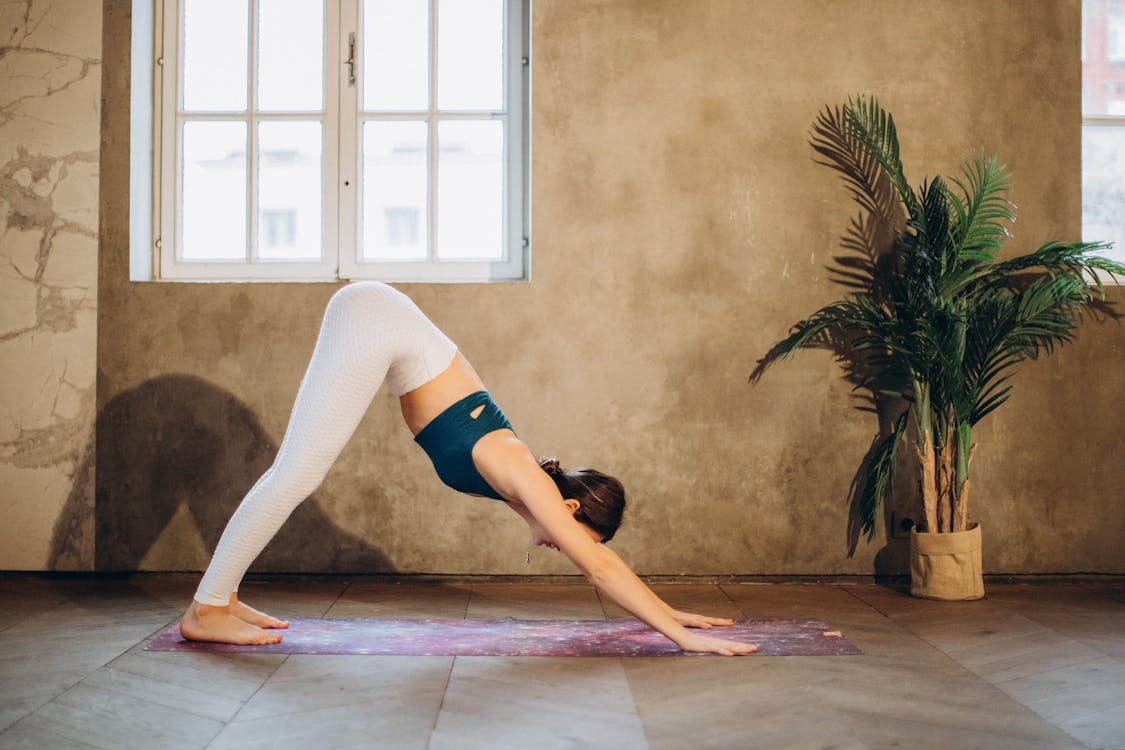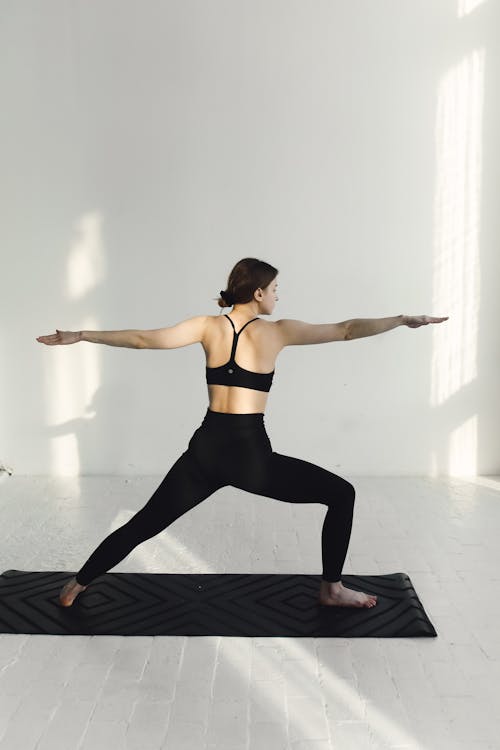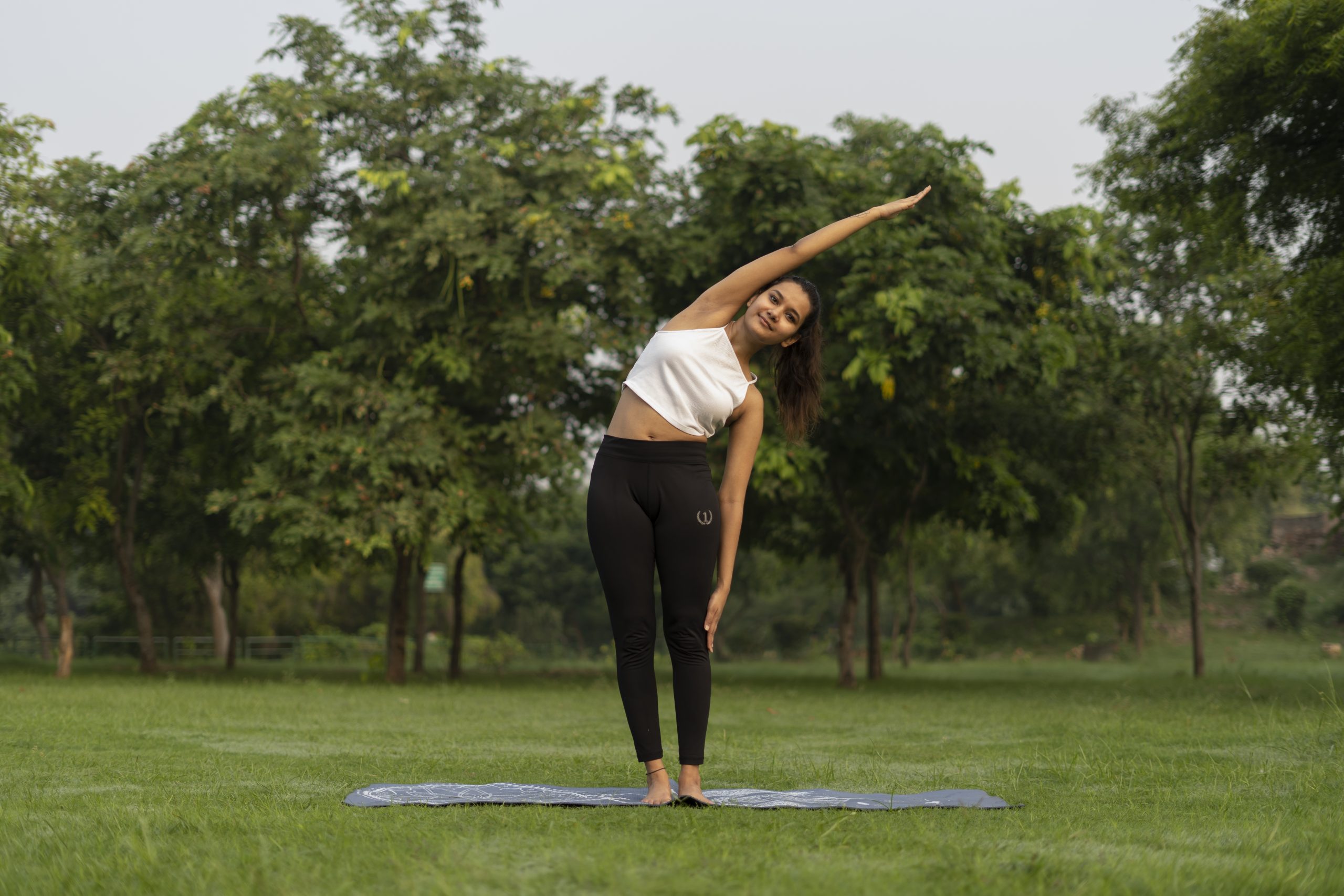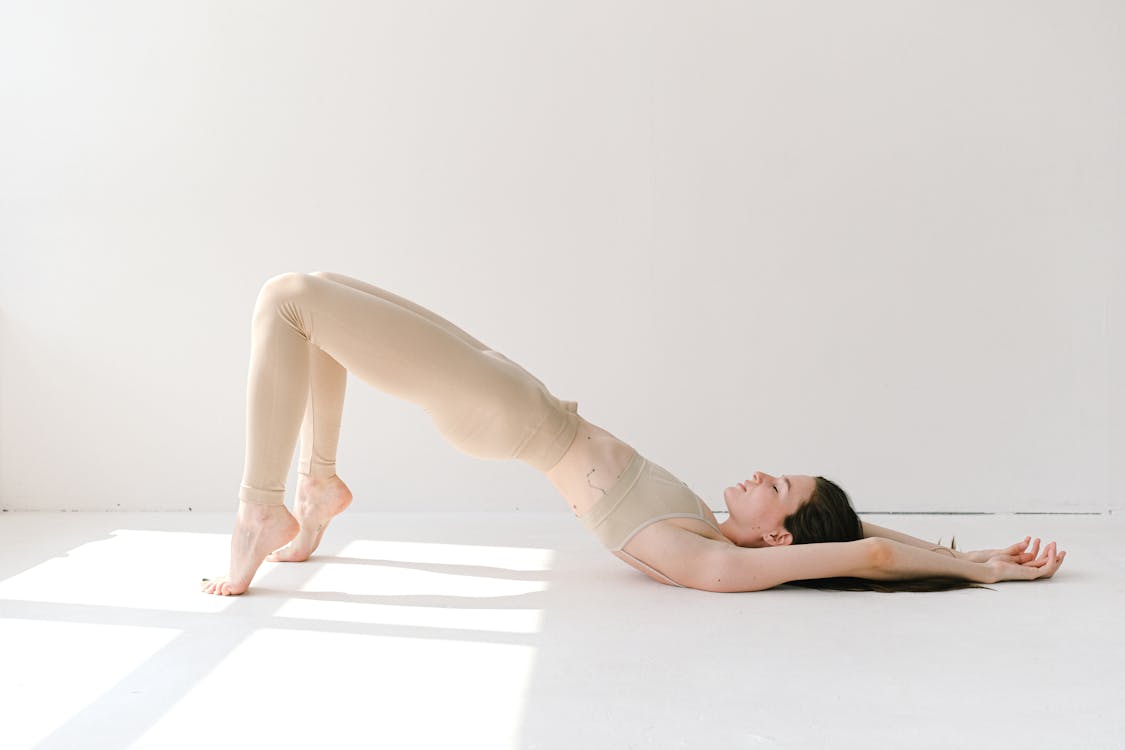
This pose is a very gentle opener for the hips and also invites a sense of ease. The pose brings a feeling of peace and tranquility. Easy Pose can be practised with your back against a wall if you are feeling very fatigued. If you are in Easy Pose for an extended period (especially for meditation), sitting on top of a blanket or two can feel very comfortable.
2. Unicorn and Rainbow Pose (Cow and Cat)

This pose sequence, often called cat and cow, helps to strengthen and maintain flexibility in the lower back and abdomen. This sequence is a very gentle way to warm the core muscles. Invite the feeling of warmth from the inside out.You can use a folded blanket under your knees to cushion them. Or you can practice this sequence standing, with feet hips width apart, a soft bend in the knees, and hands on top of the thighs.

This pose is great for core strength (TVA, obliques, lower back) and is also beneficial for balance training. This gives you a long line of energy extending in two directions (front and back), like the arrow on a compass.You can use a folded blanket under your knees to cushion them. If there is any pulling in the abdomen, lower your back toes to the ground. If there has been a lot of round ligament pain during this particular time of gestation, it is recommended that you keep the back foot on the floor the entire time.

This pose (aka Downward-Facing Dog) is a wonderful stretch for the entire back of the body from head to toe. Down Dog is also considered an inversion because the head is below the heart and the heart is below the hips. Inversions help to bring oxygenated blood to the brain as well as giving a new perspective on the world. Down Dog is a gentle inversion and often feels fantastic during pregnancy. Allow yourself to connect with the energy of Mother Earth and feel her rising up to support you and your baby.If you have nausea, heartburn or wrist pain, consider skipping this pose for the time being. Enjoy the stability on all fours instead, especially in vinyasa or flow sequences.

This pose is a hip opener that helps to keep hips strong and flexible for labour and delivery. The feeling is one of release, of letting go. It is interesting to note that when a baby exhibits the startle reflex, it is tightening the psoas. This is usually the same area in which adults experience fight-or-flight response. Check in with your breath and simply observe as you come back to the steadiness of the breath. Place a bolster underneath your pelvis so that you have a cushion as well as a nice lift for the hip with the bent knees. A blanket under the knee of the straight leg can give some cushion. The use of blocks is highly recommended here.

This pose assists with the ability to squat, which is often a position chosen for labour and delivery. The pose also helps improve range of motion of the hip joints. The feeling is one of grounding, of connecting to Mother Earth. You can place a block or several folded blankets underneath the ischial tuberosities (sit bones) for support. This especially helps if your heels do not easily touch the floor in the deep squat. This position is also great for focusing on pelvic floor strength and can be a great shape for practising Kegels and other pelvic floor exercises.

This is a safe and easy way to stretch the lower back while supporting the weight of the upper body. Enjoy the feeling of traction in your spine. As you lengthen the crown of the head away from the tailbone. If you feel as though your knees are splaying out in this pose, consider placing a block between your thighs.

This pose strengthens the hips and quads and can help to build strength in the core stabilisers – glutes, quads, hamstrings, abductors, inner thighs, abs, lower back, obliques and transverse abdominis (TVA). Imagine yourself standing on the face of a clock (see figure a). Remember that the standing foot is always pointed to twelve o’clock, so you are changing the time with the lifted foot. If you feel as though your balance is a little bit off, it is recommended that you place one of your hands on a stable surface.

This pose helps warm the entire body and cultivate strength in the lower body (quads, hamstrings, abductors, inner thighs) as you reach through a full range of motion in the upper body (flexibility training in the glenohumeral joints). The core stabilisers (TVA, abs and lower back) are also active in the sequence. The feeling is that of rising up in Warrior 1 (or Crescent Lunge), expanding your energy and power in Warrior 2, feeling a sense of the exalted power in Reverse Warrior and extending your power in Extended Side Angle.
If you are feeling as though you need a little extra support under your pelvis, you can perform this sequence on a chair. The last three poses of the sequence work better on a chair than the first one does, so it is best to begin with Warrior 2. Straddle the seat of a folding chair and bend your right knee to a 90-degree angle as you straighten the back leg and open your arms out to the sides at shoulder level. Breathe into Warrior 2 and feel the strength in your arms as you expand your energy to the front and the back. Flow into Reverse Warrior on your inhale and into Extended Side Angle on the exhale. Take a moment in a wide plié (Goddess Pose) on the chair before you change sides.

This pose strengthens the lower body with particular emphasis on the inner thigh and like the Clock Squats, can help build strength in the core stabilisers (glutes, quads, hamstrings, abductors, inner thighs, abs, lower back, obliques and TVA). Think of yourself as a ballerina, your powerful legs carry you up and down. The movement looks easy and beautiful on the outside and that is a direct result of the power and strength on the inside. If there is any challenge in keeping the upper body upright, you can place your hands on the back of a chair and use it as a ballet bar. This can help you find your balance as the weight of your growing belly and breasts begins to pull your torso forward.

This exercise strengthens the muscles of the rhomboids, also known as the posture muscles. Powerful posture muscles can help you to stand upright. As you draw your elbow back, feel the strength in the rhomboids and envision the power in the back of your body. During pregnancy, it is easy to focus on what is happening at the front of the body. This is totally normal since there is a beautiful baby growing in your belly. This exercise can be performed with a small hand-held weight or a heavy but slim water bottle. Choose a weight that is challenging enough to build strength but not so hard that you cannot draw your shoulder blades in toward your spine. It can also be beneficial to begin with your nondominant side.

This pose stretches the lower back and the outer hip of the lifted or crossed leg. This pose has a few different names. Some people call it Thread-the-Needle when it is practised seated or lying down; others call it a Figure 4 Stretch because the legs are in the configuration of the number 4. Try to find the feeling of creating strong angles in this pose to create strong alignment. This stretch is effective for releasing tensions in your lower back and is also fantastic for new mothers who might have lower back pain as a result of picking up heavy gear (car seats, prams, etc.) and then twisting while trying to turn and load gear into a car. Remember that this stretch is portable, so you can enjoy it virtually anywhere at any time.

This movement offers a dynamic stretch of the hips and lower back while also engaging the core. If you have ever baked at home, you know that little kids (and adults) often like to scrape some of the mixture off the inside of the bowl with a spatula to enjoy every bit of sweetness. Imagine that your hips are the spatula and that you are trying to scoop your hips all the way around, all 360 degrees of the circle, to get every bit of sweetness; in this case the sweetness is a satisfying stretch for your lower back and hips. You can perform this exercise while sitting on a stability or birthing ball, especially as you get closer to labour and delivery. Move slowly and make sure you are working on a non-slip surface (not carpet) and that you are either wearing supportive athletic shoes or are barefoot with your feet on a sticky mat.

This movement stretches the side body (latissimus dorsi, intercostals, obliques). Enjoy the feeling of lengthening in the side body and remember that the little muscles between your ribs help you to enjoy deep breathing. Imagine that you can breathe even deeper into the right lung as you bend to the left, and vice versa. If you are not able to bring your hands together because your shoulders are tight, you can use a yoga strap or belt. Take the strap in your hands to fill the space between your hands. Gently walk your hands as close together as is comfortable before you enter the stretch.

This pose provides a deep stretch for the inner thighs and a gentle stretch for the lower back; it’s also calming to the nervous system. Supported poses send a message to the nervous system that you are safe. Your body can settle into a deeper breath and in this variation of Wide-Legged Forward Fold, there is a literal and figurative message to the brain that this vital organ is supported and safe. Breathe deeply into the feelings of support, safety and comfort. You can add another folded blanket under your sit bones if you would like an additional cushion for your bottom. To move deeper into this pose, you can slide your forearms forward on the blocks or move the chair forward slightly to get a deeper stretch. Please be cautious and remember that even if you are very flexible, it is important to leave space for your baby and never to bear weight on your abdomen. Your belly should always hover above the floor.

This movement mobilises the muscles of the pelvic floor. Experience the feeling of mobility in the hips as though you were a child simply enjoying playtime with a beach ball. This is a valid form of exercise that has distinct benefits for pelvic mobility, but it’s also fun! If you feel unstable with this exercise, it’s OK to place your ball at arm’s length from the wall so you can tap the wall with your fingertips to reestablish your balance.

This move strengthens the hips, legs and core stabilisers. Feel a powerful sense of grounding through your feet as you enjoy this exercise. If you have a tendency to let your knees either knock in or collapse out, place a yoga block between your inner thighs to maintain the proper alignment of your knees. If you would like an added challenge, you can add a Kegel exercise at the top of the squat. Feel the lift of the pelvic floor as you rise, emphasising it as you straighten your legs.

This exercise strengthens the outer thighs and hips and stabilises the core with the ball. This exercise can be a bit humbling; it’s surprising how challenging it can be to simply lift your leg! Be patient. Prove to yourself that you have a deep reservoir of strength you can draw from as needed. You can tap the top foot to the floor any time you feel as though your balance is off. Take a moment with your foot on the floor to recalibrate and find your balance. Then continue the exercise when ready.

This movement provides deep abdominal work as well as helping you learn to coordinate the strength and balance in the pelvic girdle. Envision the hip bones as a set of scales. Let the scales be completely even so that they work in harmony and balance. Neither side (especially the stronger side) takes over. Balance is the key to this exercise. As with all floor work, it’s OK to have a thin blanket folded underneath your sacrum/pelvis for padding. Make the exercise comfortable so you can stick with it and set yourself up for success.

This movement strengthens the back of the body through closed chain gluteal stabilisation. Closed chain exercise refers to movements in which the furthest part of the extremity is in a fixed position. Closed chain exercises are said to be more functional. Bridge Pose can be visualised as crossing a bridge. Place a block between your inner thighs so you have something to squeeze. This squeezing in toward the midline will help activate the stabilisers of the thighs and assist with the alignment of the pose.